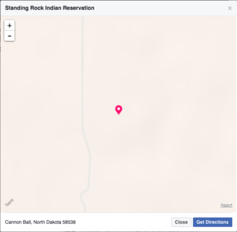 By Leshu Torchin, University of St Andrews
By Leshu Torchin, University of St Andrews
On Oct. 31, more than a million Facebook users “checked in” at Standing Rock Reservation, on the border between North and South Dakota. Since last March, the Standing Rock Sioux and other tribal communities and activists have been blocking the construction of a crude oil pipeline, which threatens sacred sites and the tribe’s water supply.
All those users who checked in had not actually traveled to the encampment. Rather, they’d been prompted by a post that went viral, claiming that the local sheriff’s department was monitoring online check-ins. It asked people to “overwhelm and confuse” this surveillance effort by using a Facebook feature to signal their presence at the protest.
This was the first time this check-in strategy appears to have been so successful. But as has happened other times online advocacy has gone viral, skepticism and derision followed. Snopes, a site dedicated to debunking Internet rumors, quickly posted an explanation: Police were not using Facebook check-ins to track protesters.
Mother Jones magazine described the action as a “waste of time.” And by titling journalist Alexis Kleinman’s otherwise helpful guide for action “Checking into Standing Rock isn’t helpful,” Mic expressed its ambivalence toward online activism. The piece’s first sentence was clear about this doubt: “Clicking a few buttons on Facebook isn’t enough to make an impact.”
But that rapid dismissal was too quick. As a scholar of media and advocacy, I’ve noticed skepticism whenever activism has attracted lots of attention. In fact, online connections can help overcome obstacles of space, time, income and knowledge to share stories and information while linking people to each other and to opportunities for action. Indeed, Mic soon revised its article headline: “Checking in at Standing Rock on Facebook is cool – but here’s how you can actually help.” That signaled an important acknowledgment: While online action alone can’t solve a problem, it can be a very useful tool to mobilize people and focus attention on a crucial issue.
Concerns about surveillance
One element of the post that caught people’s attention was the claim that police were electronically monitoring the protest. It was tempting to think that faraway individuals could help thwart that police effort by overloading them with false data.
While police say that wasn’t happening in this case, online surveillance of activists is a real and troubling phenomenon. The U.S. Department of Homeland Security has used social media to track Black Lives Matter activists and to locate vigils and actions.
Even decades ago, the practical potential of online communications for organizing and mobilizing was evident. In the 1990s, the Zapatistas in Mexico used email listservs to build support and update allies around the world. During the 2009 Green Revolution in Iran, activists used Google maps and related apps to direct demonstrators to safe spaces – and the police used that information against the protesters.
The suggestion to check in gave people not directly involved in the Standing Rock protest a plausible way to show concrete support.
Mobilizing support
The Standing Rock Sioux and their allies who were physically at the Sacred Stone camp do not appear to have called for the mass check-in action themselves. But they pronounced the Facebook activity a “great way to declare solidarity.”
 All your friends went where?! Screenshot, CC BY-SA
All your friends went where?! Screenshot, CC BY-SA
Indeed, the check-in identified more than a million Facebook users who cared enough about the Standing Rock protest to identify themselves publicly as supporters. Their numbers suggested a growing critical mass of public sympathy, in a size that could get the attention of politicians who could halt the construction.
In addition, check-ins could take advantage of Facebook’s algorithms to draw even more attention to the protest. Facebook location updates are designed to appear on the feeds of friends and to foster connections between friends who may be physically near one another. For some, this allows meeting up at a concert or sale. But in this case, users could exchange information – whether about the Snopes item, ways to contact government representatives to urge them to halt construction or a donation link for the Sacred Stone Camp Legal Defense Fund.
Forcing news coverage
The attention built to a point where the mass media could no longer ignore it. Before the check-in action, there had been minimal mainstream coverage of the Dakota Pipeline protest. That left protesters and supporters dependent on social media – and alternative media sources like Democracy Now!w and Counter Current News – to pass the word.
The use of social media and citizen journalism to bypass media blackouts is nothing new. Twitter and YouTube allowed protesters to circumvent the mainstream media during the 2009 Green Revolution in Iran. In the summer of 2013, protesters in Istanbul took to Facebook and Twitter to report on the demonstrations and the ensuing police brutality – while CNN Turk aired a documentary about penguins.
The Standing Rock check-in did more than share news; it became a newsworthy event on its own. A million people had told Facebook – and therefore their friends – that they had gone to the Dakotas to protest a crude oil pipeline. What was going on? News organizations responded.
In the process, they had to explain what was happening in this remote camp that would motivate people to go there – even virtually. There was increased coverage, including from the Washington Post, the Austin American-Statesman and London’s Telegraph newspaper. In addition to boosting coverage, the check-in action provided a story about a rising tide of public opinion supporting the protesters.
 By looking at whether the check-in itself was effective, it is easy to lose sight of the true picture. That single action was never meant to be a click to save the world – and I don’t think anyone actually thought it was intended to. Rather, it took place within a larger context of a growing movement seeking options for further action – particularly from supporters far from the actual protest site.
By looking at whether the check-in itself was effective, it is easy to lose sight of the true picture. That single action was never meant to be a click to save the world – and I don’t think anyone actually thought it was intended to. Rather, it took place within a larger context of a growing movement seeking options for further action – particularly from supporters far from the actual protest site.
Most advocacy activities are not used in isolation. The check-in was, instead, a way to amplify the reach and urgency of an important issue, to connect people with each other and to offer them new ways to act.
Whether a similar mass check-in action could work in the future remains to be seen. Some may still view the idea skeptically, in part because in this case it didn’t actually mislead the police. And Facebook itself has been less of a site for action and more of a way to share and exchange information. But for the time being, social media continues to offer opportunities for useful political organization and mobilization.
Leshu Torchin, Senior Lecturer in Film Studies, University of St Andrews. This article was originally published on The Conversation. Read the original article.
Image Credit: Pawel Kuczynski Art

well we aren’t standing with you and having your back in reality, but have no fear, we are with you in spirit from the comfort and safety of our armchairs.
facebook? as if.
Another George Soros sponsored event. Try looking under the surface at who is making money hauling oil from Baaken. Warren Buffet and his railroad BN&SF have made billions hauling Baaken crude. When the pipeline goes in Buffet and stockholders including Soros lose billions. You dummies are working for big corporate interests. The Law Firm Earth justice representing Standing Rock,funded by Soros has the goal of shutting down energy production in the US. That is treason!
You folks who support this without finding out who is behind it it are classified as useful idiots. Shutting down the pipeline is part of Agenda 21. Did you know that there are hundreds of pipelines crossing every major river in the US including the Missouri. Look at a pipeline map. Do you want to shut them all down!
The alternative media doesn’t do their research and are working at cross purposes.In fact you seem to be working for BN&SF.
Bravo~ Someone who can not only read between the lines, but follow the money too, which everyone needs to do now that almost everything that happens (that is reported anywhere, including sites like these) is either planned by tptb or financed by them, and most likely both. I do love the idea that a product of the beast could be used to take down the beast, there’s something ironically warm and fuzzy about that, but I agree that isn’t the case here. This is more of the same Hegelian Dialectic psyoptic (I think I just made that word up) nightmare of thesis, antithesis, synthesis, the synthesis being exactly as freewheelinfranklin states – shutting down energy production. When anything like this happens, work backwards from the “synthesis” or what it will accomplish, and you’ll all be able to identify the thesis and antithesis quite easily to discern its veracity. Solution = problem + reaction. Well done franklin~
And what about the destruction of the burial grounds? And the potential for poisoning local drinking water? Certainly you are correct that people should TRY to find out who is behind certain political efforts, but destruction of Native American burial grounds, along with poisoning of the water supply seem to be fairly straight-forward issues.
UNITED WE STAND should be the catch phrase on every American’s lips in these times of extreme in your face corruption all around. IF, IF, IF WE THE PEOPLE WOULD UNITE we could peacefully remove much corruption just like they did in Egypt when the removed the obama puppet morsi and the muslim brotherhood. WAKE UP SHEEPLE!!!!!! TURN OFF THE STUPID BOX AND STAND UP FOR SOMETHING! BEFORE THE RIGHT TO DO SO IS GONE FOREVER! If Hitlery makes POTUS, and signs are obvious that her CNN Clinton News Network liars are aiding and abetting her treasonous actions by flat out lying, and making up stories at the right moment to discredit everything against her, and believe it or not the FBI, instead of investigating her treason is investigating those who speak against hitlery! If she makes POTUS the constitution will be gone very quickly.
Yup, the flooding of well-pissers is beginning to be noticeable, and weirdly anof its not about clean water and secret land as it initially was about, have morphed into an theater of paranoia.
I know why Yankees never will nor want to understand, this could be solved thru other routs or do something with it but no, the Yankees demand the natives to pay, for the casino modern pipe lines are we all know that, better lat than sorry, huh.
What is it with you, this is legitimate, by all standards and church cementary are usually never touched even in city plans, but now, f…. it, right.
You dont care, but others do, thats f…. demoCracy in real time creeps, in you own land, f…..
The ugly truth is this, its you and the Gov, that does this, nobody else.
peace
At the very least the internet does seem to make them pause.
And by the use of the words ‘news agencies’ are you referencing these alt sites on account of I never believe not do I tune into those untrustworthy propaganda channels.
So many times people are told they have no power just to get them to give it all away! Do you feel that vents like this can awaken people to the real power they have? The activists at the Dakota pipeline protests need your support more than the oil companies do!